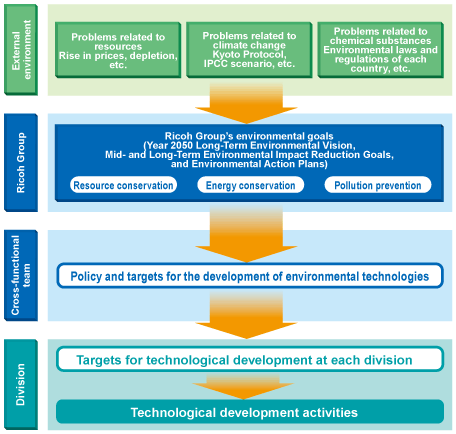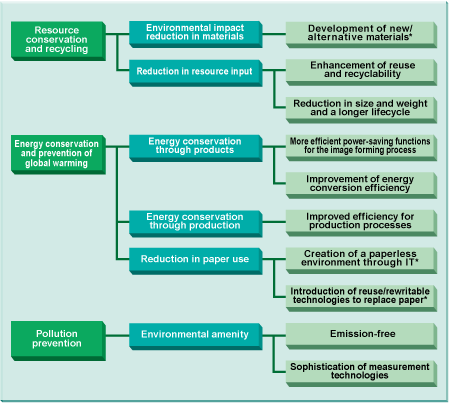- Home
- Sustainability
- Environment
- Development of Environmental Tec... | Global | Ricoh
Development of Environmental Technologies
Our aim is to bring about an "industrial revolution of the environment" through the development of innovative environmental technologies, with the goal of realizing a low-carbon society.
Concept of Developing Environmental Technologies
- Concept of Product Development
- Acceleration of development of environmental technologies
- Promotion of LCA-based design
The Ricoh Group develops products that–throughout their lifecycles–will keep their environmental impact below the limit at which the global environment becomes unsustainable. First, Eco Balance data on the environmental impact caused by overall business activities are identified and, based on the results, targets for products covered by the action plans are set (Plan). LCA-based designs are then drawn up, and production process technologies are developed to achieve the targets (Do). Results from these designs and process technologies are again reviewed alongside the Eco Balance data (Check) before being reflected in the next targets (Act). In addition to technological development directly related to products, we also work on technological development that will help reduce the environmental impact of society as a whole. We are promoting various activities–such as the development of new/ alternative materials, creation of a paperless environment through information technologies, and introduction of reuse/rewritable technologies to replace paper–to further evolve Ricohfs core technologies into environmental technologies that can be applied in a wider variety of areas.
Focused areas for environmental technologies
- *Technologies that will contribute to environmental impact reduction throughout society.
The development of environmental technologies is one of the most important efforts to realize sustainable environmental management. It is the basis for providing customers with products that are low in environmental impact throughout their lifecycle from the procurement of materials and use by customers to their recycling, as well as for simultaneously realizing both a reduction in environmental impact and the creation of economic value.
The Ricoh Group is well aware that existing technologies are not sufficient for creating products that will help resolve the current problems of climate change and resource depletion, meet environmental laws and regulations, and expedite the realization of a low-carbon and resource-recirculating society. Ricohfs development of environmental technologies is based on this recognition. In fiscal 2009, we set targets for each stage of the product lifecycle in terms of technology development according to the Group's 2050 Long-Term/2020 Mid-Term Environmental Impact Reduction Goals and drew up technological strategies to achieve these targets. In fiscal 2010, our focus will be on enhancing the system that facilitates cross-cutting cooperation between different technology areas, aiming at more effective development activities concerning environmental technologies. In addition, looking at the 2020 mid-term goals, we will accelerate efforts to advance our environmental technology development, thereby increasing the potential for further reductions in environmental impact.

LCA-based design is a process where targets are set to reduce the environmental impact of products throughout their lifecycles, and the PDCA cycle is used to achieve these targets. Ricoh developed the LCA calculation tool in fi scal 2006 to enable designers to carry out LCA-based design in a more effi cient and effective manner. This tool is now actively utilized to conduct LCA for products in the process of development based on their specifi cations, and, in accordance with the results, set environmental impact reduction goals for each product.
Promotion of LCA-based design
LCA means quantitatively identifying which and how much environmental impact exists in the lifecycle of a product, from the resource extraction for the production of raw materials to manufacturing, transportation, marketing, use, maintenance, collection, recycling, and disposal. LCA may also be applied to part of the above cycle.
Published national patent applications in Japan for environmental technologies(energy-saving, recycling, resouce-circulation, waste reduction, etc.) increased in recent years as indicated below.
| FY2011 | FY2012 | FY2013 | FY2014 | |
|---|---|---|---|---|
| Number of national patent applications published related to environmental technologies(PY%) | 14% | 6% | -1% | 17% |
Fundamental Technologies
We develop fundamental technologies that contribute to reducing environmental impact of society as a whole with an eye toward applying these technologies to a wider range of fields in addition to underpinning Ricoh’s products and production processes.
Product Technologies
We are working to reduce the environmental impact of our products by developing LCA-based designs and energy-saving technologies.
Our Activities
- Aqueous Resin Type Inkjet Ink
- Photo (UV)-curable Inkjet Ink
- Smart Position Motor System
- Color QSU Technology by Direct Heating System
- Color PxP-EQ Toner
- Improve efficiency of ink use by minimizing ink waste
- Rewritable Printing Technology
- Biomass Plastic Material Technology
- Biomass Toner Technology
- Product Life-cycle Environmental Impact Assessment Technology
Production Technologies
Aiming to produce high-quality products with less environmental impact, we are working to develop environment-friendly technologies to be applied in manufacturing and recycling processes.


